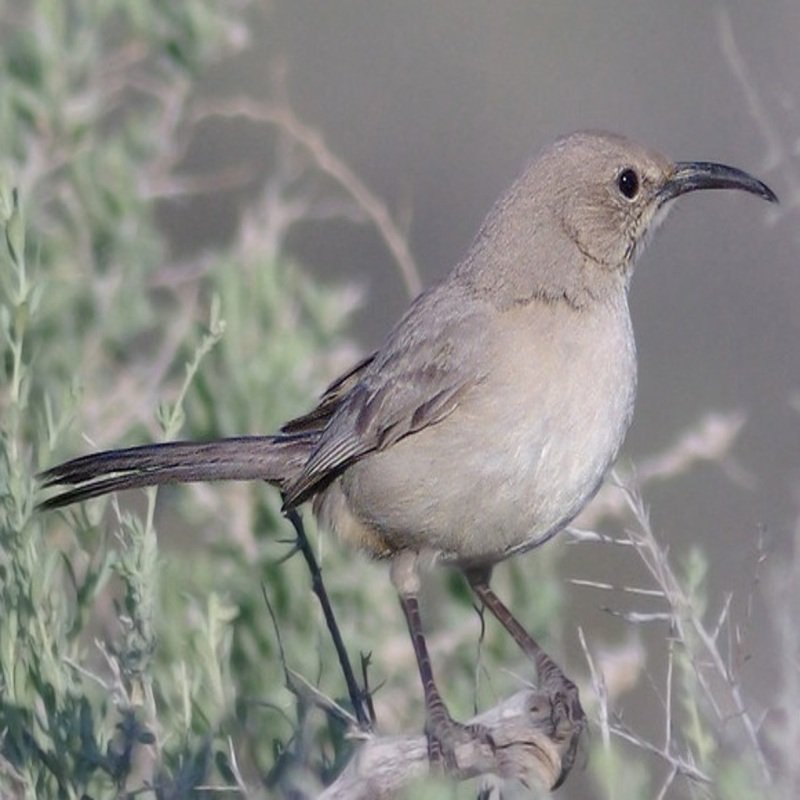Know to be LeConte’s thrasher, with the scientific name of Toxostoma Lecontei, is a pale bird that can be found in the southwestern United States and northern Mexico. It prefers to live in deserts with little vegetation, where it can blend in with the sand-covered soils of the environment. Unlike other thrashers, LeConte’s thrashers are nonmigratory birds that return to the same territory year after year. Despite the fact that the species’ abundance has been decreasing in some parts of its range, particularly California, the species is still considered abundant enough to avoid being designated as vulnerable. This species is in the family of Mimidae.
Quick Overview: Toxostoma Lecontei – LeConte’s Thrasher
Body size: Around 10-11 in (25-28 cm) and a weight of 62 g (2.2 oz)
Main colors: Gray-Brown, Black, Gray
Range: Southwestern United States
Migratory Bird: No
Best time of the year to see in the U.S.: All Year (January – December)
Conservation Status: Vulnerable
LeConte’s thrasher Description
LeConte’s thrashers are large, sexually monomorphic songbirds that are light gray-brown in color with a long, strongly decurved bill with black color and rusty crissum on the back of the neck (feathers under the base of the tail). The breast is unmarked, but there is a sharp, narrow gular mark on the right side of the body.

Size
These birds have a length of 10-11 in (25-28 cm) and a weight of 62 g (2.2 oz). Their wings could range from 12-13 in (30-33 cm).
Feeding
It feeds almost exclusively on insects and other small invertebrates, to which it adds small soft fruits later in the year. When feeding on fruits, it can be found in exposed areas, but it is more commonly found in protected areas.
Habitat
Using its bill, the California thrasher forages primarily on the ground, where it digs and rakes leaf litter and soil. It moves by walking or hopping between foraging locations. They can scratch on the ground for bugs in the Mojave Desert Scrub, which is extremely dry and difficult to navigate.
Behavior
In addition to building nests and feeding young, this thrasher is a highly terrestrial bird. It runs faster than a trotting horse. When running, it holds its tail up, revealing its buffy crissum. The LeConte’s thrasher digs small pits in leaf litter or soil to find prey. It is a monogamous species, seen in pairs, and juveniles in groups of two to eight birds.
Toxostoma lecontei Scientific Classification
- Kingdom: Animalia
- Phylum: Arthropoda
- Subphylum: Chelicerata
- Class: Aves
- Order: Passeriformes
- Family: Mimidae
- Genus: Toxostoma
- Species: Toxostoma lecontei
Subspecies
There are two subspecies identify in these species namely: T.l. lecontei – the range is from the southwestern United States to northwestern Mexico and T.l. arenicola on the west coast of Baja California.
Best time of the year to see
Regardless of the season, these birds are commonly seeing all year round from January until December foraging in places in the United States
Distribution of the LeConte’s thrasher in the USA
The population of this bird is estimated to be close to 200,000 individuals, according to some estimates. The United States and Mexico are home to this bird’s natural habitat. A resident species throughout its range, this bird can be found from southern California as far west as the San Joaquin Valley through southern Nevada and southwestern Utah, as well as central and southern Arizona, Colorado, New Mexico, Oklahoma, Texas, and this bird, is found throughout its range.

